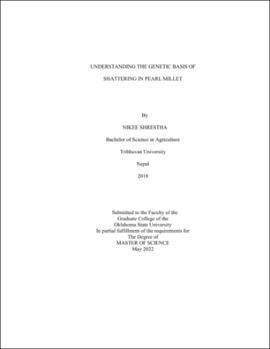| dc.description.abstract | Over the last years, genes involved in several traits targeted during domestication have been studied in crops. Because shattering is an important domestication and agronomic trait, it has been intensively studied in crops such as rice, sorghum, Setaria, maize, wheat, and barley. However, shattering-related genes found in major cereal crops such as rice and wheat have not been validated in other crops. Additionally, recent transcriptomic analysis of abscission zone tissues from three grasses; a de-domesticated Oryza accession, and accessions of the wild species Setaria viridis and phylogenetically distant from each other have further supported the hypothesis of independent selection on genes for shattering between different grass species. However, it leaves the question of whether closely related genera might share similar shattering mechanisms. Hence, I have chosen to identify genomic regions associated with reduced shattering in pearl millet and compare them to identified genomic regions for shattering in the closely related genus, Setaria, as well as in the distantly related cereal species, rice. The wild relative, Cenchrus americanus ssp. violaceum (monodii), easily shatters by breaking at the base of the primary branch where the pedicel of the spikelet joins the rachis. Domesticated pearl millet, Cenchrus americanus ssp. americanus, does not break at this location, making it non-shattering. A histological and SEM analysis of the shattering zone shows a unique indentation of the epidermis that is present from early development of the primary rachis branches in both domesticated and wild accessions. I crossed accessions of domesticated pearl millet and wild pearl millet; and created an F2 population of 387 plants. Phenotyping of the F2 and F2:3 populations through a simple hand grasping method suggested that it followed a 15:1 segregation ratio (p=0.223) suggesting that two loci might be responsible for the non-shattering trait in pearl millet. I measured the force to detach the primary branch with a force gauge 28 days after heading, and mapped genetic loci associated with this trait using a high-density linkage map to identify quantitative trait loci associated with shattering. QTL mapping revealed a major QTL on chromosome 3 and a minor QTL on chromosome 5 associated with the shattering phenotype. This was confirmed by QTL analysis of the qualitative hand-shattering phenotyping trait identified in the F2 and F2:3 populations. Comparative genomics of QTL positions amongst grasses showed no conservation, which suggests, along with the histological details, that the shattering mechanism in wild millet is unique in grasses. | |
